More than a year into the COVID-19 pandemic, our knowledge about and response to the virus have changed again and again. As vaccines roll out and infection rates tick down in the US, though, there’s an aura of hope in much of the country.
But how are senior living communities feeling?
They were hit particularly hard by the pandemic on several fronts:
- Senior living residents are among those most susceptible to the virus.
- The group activities that make these communities so attractive were suddenly verboten.
- Tours that drive new business were forced to go virtual.
- Family visits – a key part of resident wellness – were forced to go digital.
To get a sense of how senior living operators are feeling, we surveyed 30 communities around the country three times in the last year: first in August, again in November, and again in April. (Note: We did not sample the same 30 communities each time.)
Here are the questions we asked:
- Do you currently have any COVID cases?
- Did you previously have any COVID cases?
- Are you allowing in-person family visits?
- Are you offering physical tours?
- Is the dining room open?
- Do new residents have to quarantine when they move in?
The answers paint a picture of the progress we’ve made in combating the virus in the last nine months and make a compelling case that senior living is, for the most part, back.
Curious about how your local competitors stack up on these questions? Let us know – we’d love to draw up a competition analysis for any of your markets.
1. Do You Currently Have Any COVID Cases at the Community?

Figure 1: Current cases decline from 27% (Aug. 2020) to 17% (Nov. 2020) to 7% (Apr. 2021)
The first question we asked was whether a community had any current cases of COVID, either among residents or staff.
In August, 27 percent did, in November 17 percent did, and in April just seven percent did. These numbers are exactly what we’d expect as we learned more about how to minimize the spread of cases and as access to PPE normalized around the country.
Two points are particularly worth noting:
- When we conducted the November survey, we were in a national surge (see Figure 2). It speaks to these communities’ commitment to safety and adaptability that numbers went down in November even as they were going up around the country.
- While the current seven percent number is fantastically low, it’s also not zero. This is a reminder that, even with stringent safety protocol, widespread vaccination, and much better knowledge about how to prevent the spread of COVID, it’s still breaking through – which suggests that it may be a factor senior living operators have to deal with for years to come.
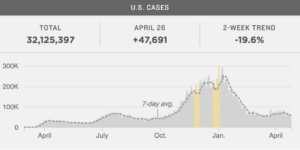
Figure 2: COVID cases surged in Nov. 2020 (Source, powered by JHU data)
2. Did You Previously Have Any COVID Cases?
With this question, we hoped to provide some context for the previous one. While a community might not have had an active infection at the time we spoke to them, knowing whether or not they’d experienced infection at any point in the pandemic would give us a sense of how pervasive the virus was.
As expected, the number of communities that answered “yes” to this question grew over time.
By April 2021, just 15 percent of the communities we sampled had remained COVID-free since the start of the pandemic (see Figure 3).

Figure 3: Previous cases rise from 47% (Aug. 2020) to 60% (Nov. 2020) to 85% (Apr. 2021)
We wondered if the four communities reporting no cases in April had anything in common – for example, were they in a state with particularly strict COVID protocols or in counties that issued mask mandates early on?
We didn’t find a pattern.
The good news here is that, regardless of state and local government response to public health crises, senior living communities with the right precautions and protocols can keep their residents and staff safe and healthy.
3. Are You Allowing In-Person Family Visits?
Some reporting on COVID-19 has named loneliness a kind of “second pandemic” affecting seniors who have been unable to see their loved ones over the last 13+ months.
It may sound dramatic, but it’s not really an overstatement. In June of 2020, the number of 50- to 80-year-old adults who reported feeling isolated from others (56 percent) had more than doubled from 2018 (27 percent).
What’s more, CDC research shows that social isolation…
- Increases a person’s risk of premature death from all causes.
- Increases dementia risk by about half.
- Increases the risk of heart disease by 29 percent and stroke by 32 percent.
- Is linked to higher rates of depression, anxiety, and suicide.
- Leads to much worse outcomes among patients who have heart failure.
But given the risks that COVID-19 poses, senior living community operators found themselves between a rock and a hard place: open up visits and risk serious illness and death in the short term or keep visits closed and risk increased rates of all kinds of health problems in the long term.
That’s why we were so encouraged to see that family visits are currently allowed at 100 percent of the communities we surveyed.
That’s a huge leap from August 2020, when just over a third of communities were allowing family visits – and many of those only through residents’ windows or in outside venues.
Still, we’re not entirely out of the woods. While every community we talked to is welcoming family members, most are doing so with conditions. A few of the most common:
- Yes, if both parties are vaccinated
- Yes, for just 20 minutes at a time
- Yes, for just two family members at a time
- Yes, but only once per week
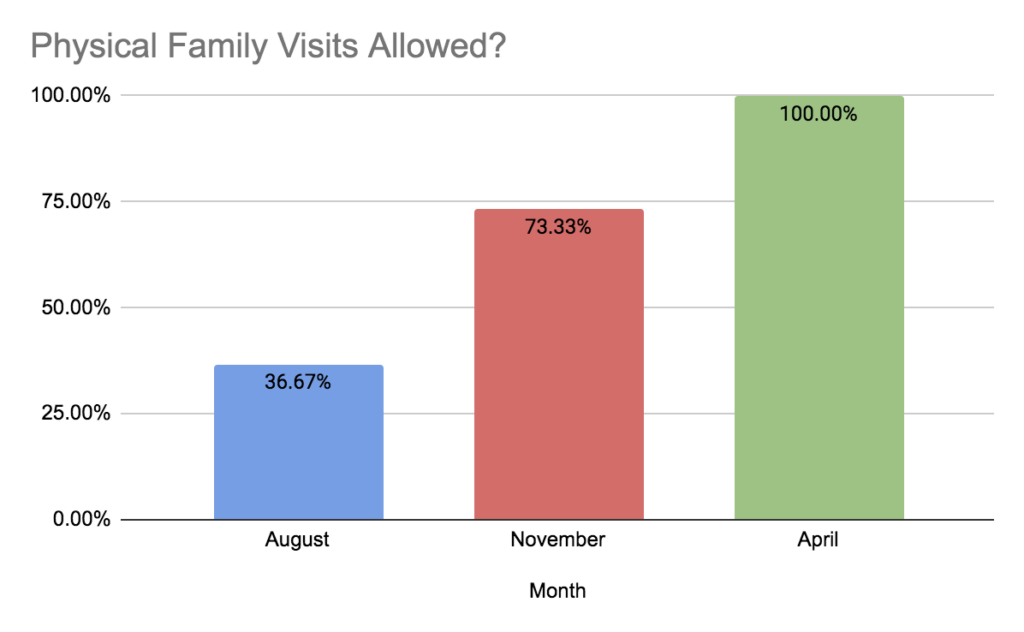
Figure 4: 37% of communities allowed family visits in August, 73% in November, and 100% in April.
4. Are You Offering Physical Tours?
The physical tour is a huge selling point for many senior living communities.
A Caring.com study from 2015 found that, even after seeing online photos of a community, 68 percent of those who took tours were “surprised by how nice it was.”
What’s changed since then? A lot of new construction and updates in the senior living space as the bar for quality is raised ever higher.
In other words: in-person tours are among the most powerful sales tools senior living communities have.
The good news today is that 96 percent of the communities we surveyed are currently allowing them.
What’s most interesting to us is that, for the periods we surveyed, in-person tour rates never dipped below 50 percent (see Figure 5). Admittedly, some of those “in-person” tours were modified versions, such as…
- Tours of a model unit you could view from outside, plus a full virtual tour.
- Window visits.
- Tours of the building’s outside structure only, supplemented with virtual tours.
Given what we know about the virus, these moves were incredibly savvy on the part of communities: in that survey we cited earlier, a whopping 91 percent of people mentioned having a positive impression of the staff they met. So finding safe (read: outdoor) ways to interact with potential residents was likely key to maintaining pipelines in the last nine months.
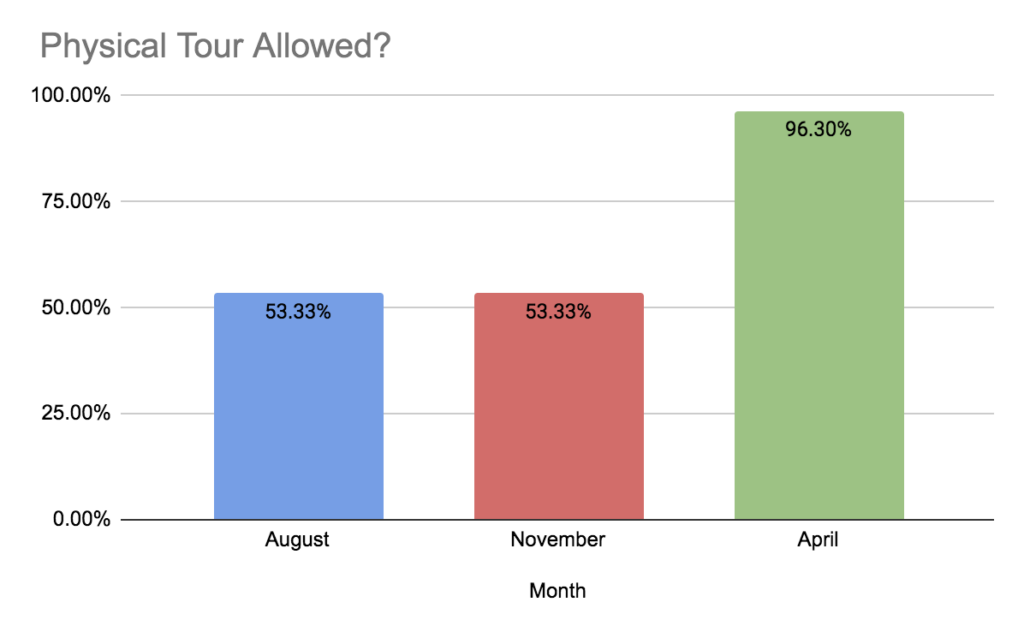
Figure 5: 53% of communities allowed in-person tours in August, 53% in November, and 96% in April.
5. Is the Dining Room Open?
For much of 2020, community dining rooms were closed. Meals were served in residents’ rooms instead. Today, dining rooms are open in 93 percent of communities.
But again, that’s not to say things are back to normal. Among communities that reported that their dining rooms have reopened, many added conditions: some were open at 60 percent capacity, for example; others were serving lunch and dinner communally but asking that residents eat breakfast in their rooms.
Still, 93 percent is a significant improvement from August’s 43 percent (see Figure 6).
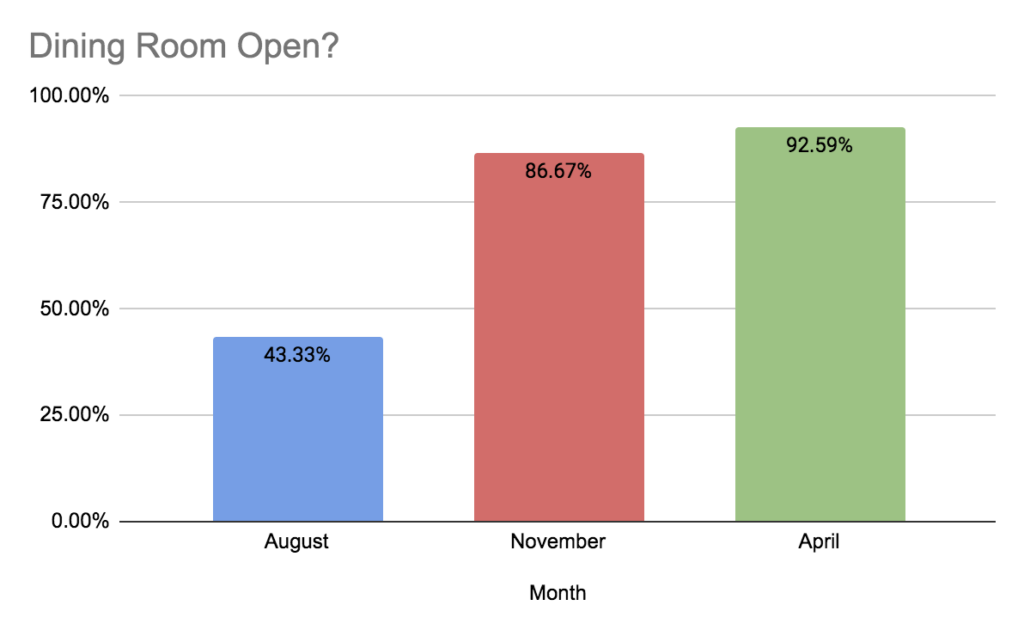
Figure 6: 43% of dining rooms were open in August, 87% in November, and 93% in April.
6. Do New Residents Have to Quarantine in Their Room?
This question offered an interesting finding that offers insight into the way our understanding of and response to the pandemic has evolved. First, the numbers (Figure 7).
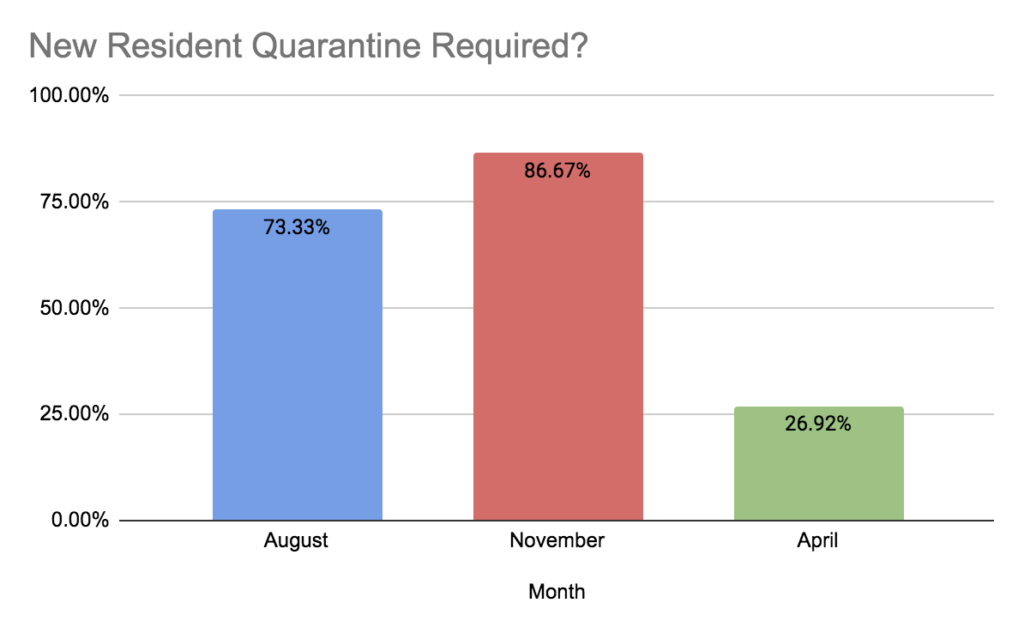
Figure 7: New resident quarantine requirements climbed from 73% in August to 87% in November, then shrank to 27% in April.
The obvious explanation for the November jump is that we were in a surge of new cases then. Our guess is that, given the rise in cases, communities put extra safety measures in place to ensure that COVID didn’t spread from outside sources. In addition, communities were likely being extra cautious around the holidays, given the likelihood of family gatherings.
The most common quarantine requirement in August and November was a quarantine that lasted two weeks (per CDC guidance) or until the resident had a negative COVID test.
By April, the game had changed. With vaccines widely available to the senior population, many communities had added a third category to their quarantine requirements: none required, assuming the resident is vaccinated (see Figure 8).

Figure 8: Roughly half of communities tie quarantine requirements to vaccination status.
These requirements make perfect sense from a public health perspective. But with some 55 percent of older adults in the “vaccine hesitant” camp, senior living communities may find themselves with yet another new challenge this year: convincing current residents (and staff) to get vaccinated.
The issue could be particularly thorny among residents who increased their social media consumption during the last year, as anti-vaccine conspiracy theories flourish on those platforms.
The Big Picture: Toward Normalcy in Summer 2021
While senior living communities may never fully return to their pre-pandemic normal, the outlook is rosy for summer 2021. Low infection rates combined with the return of group dining and family visits mean that the social benefits senior living communities offer are restored.
In-person tours may prove particularly effective for those who have been cooped up in their homes for a year and are eager for a change of scenery.
In other words, expect a strong summer sales season.
And of course, if you’re interested in seeing how these (and other) data points are trending among your local competitors, give us a shout. We’d be happy to put together a local market competition analysis.
Are there other questions we should be asking in our next survey of communities? Let us know what you think!
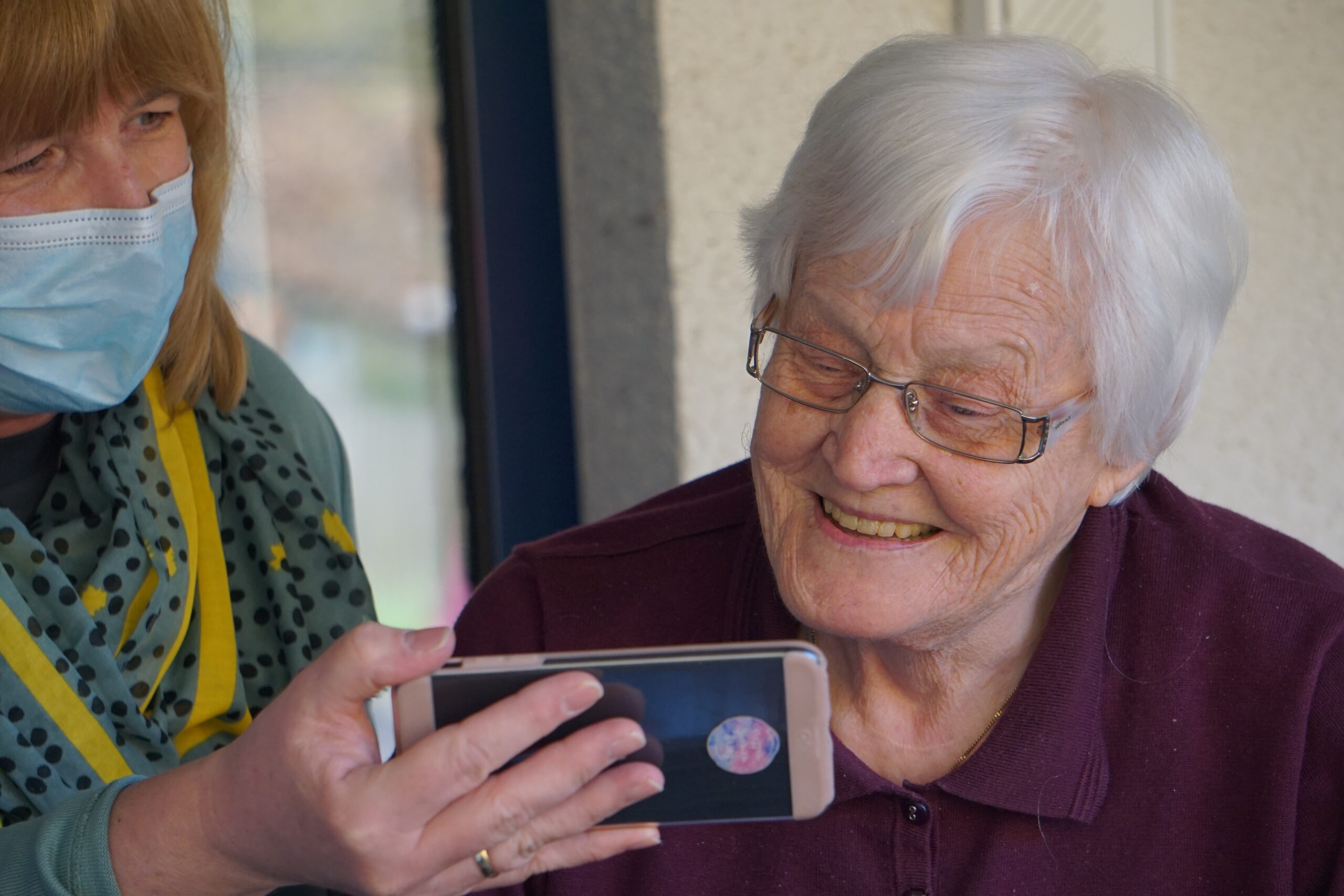



Thank you for this overview. My family is in the process of “shopping around” for senior communities for my father now that my mother has passed. We have been hesitant to tour facilities in person, but are finding it difficult to make a decision without looking around. This makes me feel much better about looking inside buildings and the grounds without posing a risk to residents.